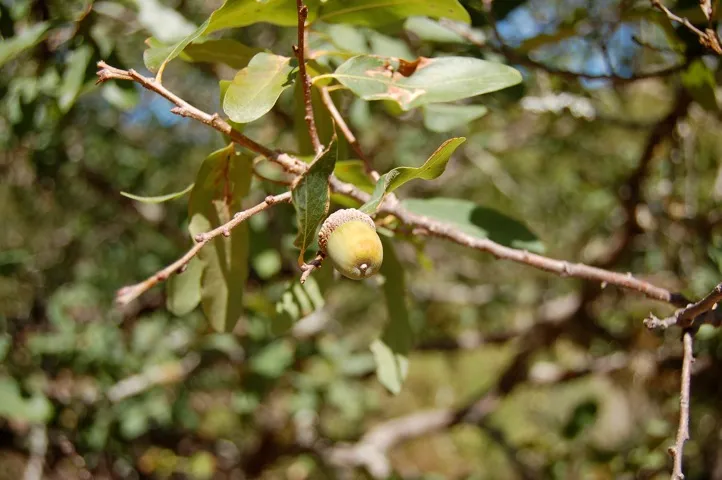By Delmar Cain
There is little that is more satisfying than spending time, even if it is only briefly, with an old friend. Bill Ward, the creator of Native Grown, died in January but had written about the Lacey oak in his column, published in January 2007. Since the Boerne Chapter of NPSOT again has selected the Lacey oak (Quercus laceyi) as the NICE Plant of the Month for October, what better way to learn about it than from Bill. I hope that you don’t mind that I have added a few comments with current information to his previously published article.
Lacey oak, a NICE! little tree for Hill Country yards
A happy surprise for me several years ago when I began paying more attention to the trees of the Hill Country was “discovering” the Lacey oak (Quercus laceyi). I especially was struck by the graygreen foliage, which in some lights has a bluish cast. In fact, many people refer to this tree as “blue oak.”
Blue is my favorite color for anything; so Lacey oak is one of my favorite native trees. I was glad the committee for Operation NICE! (Natives Instead of the Common Exotics!) chose to start the new year with Lacey oak as Plant of the Month for January. My only fear is that the local nurseries may not be able to get an adequate supply from their wholesalers. Lacey oak is available from wholesale nurseries only intermittently.
[Delmar: I know that you like your blue, Bill, but I am partial to that soft peach color of the emerging spring leaves on the Lacey oak. And this year we are making it the plant of the month for October. But Bill, you are absolutely right in your concern about finding it at the local nurseries.]
The Lacey oak grows fairly slowly into a small-to-medium-size tree. Maximum height is about 45 feet. It is drought-resistant and immune to oak wilt. Lacey oak prefers good drainage and calcareous soils.
[Delmar: Bill, I am sorry to say that current research is not confirming that the Lacey oak is totally immune to oak wilt. As you know it is in the white oak group and is therefore more resistant to oak wilt than our red oaks. I think that recent information just may leave it at that. But it can take the drought.]
The Boerne Chapter of the Native Plant Society of Texas provides free planting and care instructions for Lacey oak at nurseries participating in Operation NICE! (Hill Country African Violets and Nursery, Barkley’s Nursery Center, and Maldonado Landscape and Nursery).
[Delmar: Bill, I guess that you didn’t notice that Barkley’s Nursery has gone out of business. I checked with Hill Country African Violets and Nursery, which still carries some native plants, but is currently out of Lacey oaks. However your good friends at Medina Garden Nursery and Natives of Texas, both on Highway 16, are still keeping the Lacy Oaks in stock. Also I might mention that the Boerne NPSOT gives planting instructions for the plant of the month on its website: http://www.npsot.org/wp/boerne/.]
Where I’ve noticed this tree in the Boerne area is mostly on the highest hilltops capped by Edwards limestone. I wonder whether it grows on Edwards limestone because it likes the well-drained higher elevations or whether it favors the more-pure limestone of the Edwards, as opposed to the clayey limestones of the Glen Rose Formation at lower elevations. The little Lacey oak planted in our Glen Rose yard seems to be doing just fine.
[Delmar: Bill, everything in your yard always grows just fine. But the rest of us need to make sure that we have a spot that drains well for the Lacey oak.]
In Texas, the Lacey oak is restricted to the Edwards Plateau and just west of the Pecos River. It also grows in the mountains of northeastern Mexico, south to Oaxaca.
Lacey oak is named for the Hill Country rancher and naturalist who first introduced this tree to the botanical community. According to the “Handbook of Texas Online,” Howard George Lacey maintained a ranch on Turtle Creek seven miles southwest of Kerrville from 1882 to 1919.
This is an area where steep hills are capped by Edwards limestone; therefore I can guess that Mr. Lacey discovered his namesake tree on a limestone hill high above Turtle Creek.
Howard Lacey was born into an aristocratic family in Dorset County, England. At the age of 26, after graduating from Cambridge University, he immigrated to the US and settled in Kerr County, Texas. Besides gaining recognition as a breeder of Angora goats, he was acclaimed as a naturalist. He made collections of fauna and flora of the region and corresponded with scientists in Europe and throughout the US.
His work with the Smithsonian Institute, British Museum of Natural History, American Ornithological Union, Audubon Society, and National Geographic Society earned his reputation as an authority on natural history of the Texas Hill Country. In recognition for his contributions to zoology, three small mammals (the brush mouse, the white-ankled mouse, and a harvest mouse) were named in his honor.
Howard Lacey fell into ill health in his early sixties. He sold his ranch in 1919, donated his collection of specimens to the Witte Museum, and moved back to England. He died there in 1929. There is no record that Lacey ever married or had children. That may account for how he had time to ranch and also do extensive collecting and documentation of Hill Country species.
[Delmar: There you go again Bill, always the teacher. I don’t suppose your research indicated whether Lacey kept any of those mice as pets. You know these scientific types are sometimes into unusual pets like turtles, vultures and horned toads.
Well, thanks again for having shared your knowledge with us about the Lacey oak, designated a Texas Superstar tree by the Texas A&M University Agriculture Program.]





